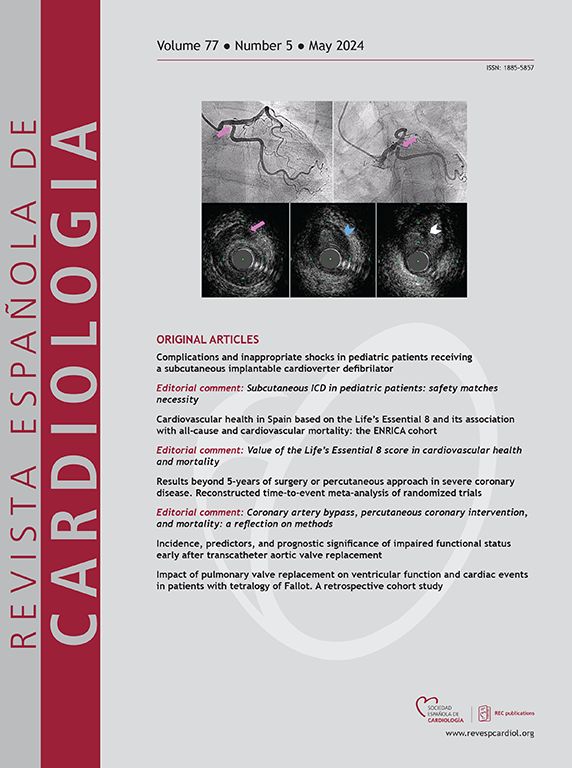对 CHA2DS2-VASc 和 HAS-BLED 量表预测心房颤动患者缺血性中风和大出血的动态评估
IF 5.9
2区 医学
Q2 Medicine
引用次数: 0
摘要
导言和目的心房颤动(AF)的卒中和出血风险通常在基线时进行评估,以预测数年后的结果。我们研究了 CHA2DS2-VASc 和 HAS-BLED 评分随着时间推移的动态变化是否会改变风险预测。在为期 6 年的随访中,记录了所有缺血性脑卒中/短暂性脑缺血发作(TIA)和大出血事件。每两年重新计算一次 CHA2DS2-VASc 和 HAS-BLED,并在两年期间检测临床结果。随访期间,156 名患者(11.5%)发生了缺血性中风/TIA,269 名患者(19.8%)发生了大出血。与基线 CHA2DS2-VASc 相比,在 2 年时重新计算的 CHA2DS2-VASc 对 2 至 4 年期间缺血性中风/TIA 的预测能力更高。综合辨别改进(IDI)和净再分类改进(NRI)显示灵敏度有所提高,再分类效果更好。与基线 CHA2DS2-VASc 相比,4 年后重新计算的 CHA2DS2-VASc 在 4 至 6 年期间具有更好的预测性能,IDI 有所提高,重新分类能力也有所增强。在 2 至 4 年期间,重新计算的 2 年期 HAS-BLED 对大出血的预测能力高于基线评分,灵敏度和再分类能力显著提高。与基线评分相比,4 年后重新计算的 HAS-BLED 评分的灵敏度略有提高。应定期重新评估 CHA2DS2-VASc 和 HAS-BLED 评分,尤其是为了准确预测卒中风险。本文章由计算机程序翻译,如有差异,请以英文原文为准。
Evaluación dinámica de las escalas CHA2DS2-VASc y HAS-BLED para predecir ictus isquémico y hemorragia mayor en pacientes con fibrilación auricular
Introduction and objectives
Stroke and bleeding risks in atrial fibrillation (AF) are often assessed at baseline to predict outcomes years later. We investigated whether dynamic changes in CHA2DS2-VASc and HAS-BLED scores over time modify risk prediction.
Methods
We included patients with AF who were stable while taking vitamin K antagonists. During a 6-year follow-up, all ischemic strokes/transient ischemic attacks (TIAs) and major bleeding events were recorded. CHA2DS2-VASc and HAS-BLED were recalculated every 2-years and tested for clinical outcomes at 2-year periods.
Results
We included 1361 patients (mean CHA2DS2-VASc and HAS-BLED 4.0 ± 1.7 and 2.9 ± 1.2). During the follow-up, 156 (11.5%) patients had an ischemic stroke/TIA and 269 (19.8%) had a major bleeding event. Compared with the baseline CHA2DS2-VASc, the CHA2DS2-VASc recalculated at 2 years had higher predictive ability for ischemic stroke/TIA during the period from 2 to 4 years. Integrated discrimination improvement (IDI) and net reclassification improvement (NRI) showed improvements in sensitivity and better reclassification. The CHA2DS2-VASc recalculated at 4 years had better predictive performance than the baseline CHA2DS2-VASc during the period from 4 to 6 years, with an improvement in IDI and an enhancement of the reclassification. The recalculated HAS-BLED at 2-years had higher predictive ability than the baseline score for major bleeding during the period from 2 to 4 years, with significant improvements in sensitivity and reclassification. A slight enhancement in sensitivity was observed with the HAS-BLED score recalculated at 4 years compared with the baseline score.
Conclusions
In AF patients, stroke and bleeding risks are dynamic and change over time. The CHA2DS2-VASc and HAS-BLED scores should be regularly reassessed, particularly for accurate stroke risk prediction.
求助全文
通过发布文献求助,成功后即可免费获取论文全文。
去求助
来源期刊

Revista espanola de cardiologia
医学-心血管系统
CiteScore
4.20
自引率
13.60%
发文量
257
审稿时长
28 days
期刊介绍:
Revista Española de Cardiología, Revista bilingüe científica internacional, dedicada a las enfermedades cardiovasculares, es la publicación oficial de la Sociedad Española de Cardiología.
 求助内容:
求助内容: 应助结果提醒方式:
应助结果提醒方式:


